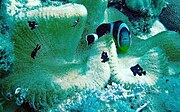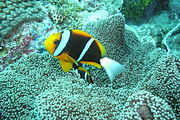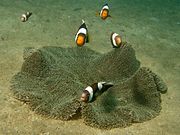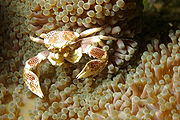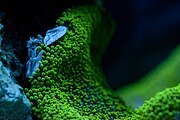Stichodactyla haddoni
| Stichodactyla haddoni | |
|---|---|

| |
| Scientific classification | |
| Domain: | Eukaryota |
| Kingdom: | Animalia |
| Phylum: | Cnidaria |
| Class: | Hexacorallia |
| Order: | Actiniaria |
| Family: | Stichodactylidae |
| Genus: | Stichodactyla |
| Species: | S. haddoni
|
| Binomial name | |
| Stichodactyla haddoni (Saville-Kent, 1893)
| |
| Synonyms | |
| |
Stichodactyla haddoni, commonly known as Haddon's sea anemone, is a species of sea anemone belonging to the family Stichodactylidae. It is found in the Indo-Pacific area.
Description
[edit]S. haddoni is characterized by a folded oral disc that reaches 50–80 cm (20–31 in) in diameter with a 1–2 cm (0.4–0.8 in) tentacle-free oral area. The tentacles have a rounded tip and the end may be green, yellow, gray, or rarely, blue and pink. The column, external structure of an anemone visible when the animal is closed, has small, non-adhesive bumps (verrucae) which are usually the same color as the column and not visible. The tentacles are yellowish or tan. At the circumference it has alternating short and long tentacles.[1]
Distribution and habitat
[edit]S. haddoni is found on sandy surfaces and is widespread throughout the tropical and subtropical waters of the Indo-Pacific area from Mauritius to Fiji and from the Ryukyu Islands of southern Japan to Australia.[1]
Biology
[edit]S. haddoni feeds in two ways. The first is internal via photosynthesis of its symbiotic zooxanthellae, living in its tissues. And the second is through capturing its prey via its tentacles that allow it to immobilize its prey (small invertebrates, fry or juvenile fish), by using toxins such as SHTX.[2]
S. haddoni lives in association with six different species of clownfish:[1]
- Amphiprion akindynos (Barrier reef anemonefish)
- A. chrysogaster (Mauritian anemonefish)
- A. chrysopterus (Orange-fin anemonefish)
- A. clarkii (Clark's anemonefish)
- A. polymnus (Saddleback anemonefish)
- A. sebae (Sebae anemonefish)
Juvenile Dascyllus trimaculatus also associate with S. haddoni.[1] A number of other species are associated with S. haddoni, however the relationship is commensal rather than mutual as the anemone does not appear to benefit from the association. These species are
- Neopetrolisthes maculatus, a porcelain crab
- Shrimp from the genus Periclimenes
- Thor amboinensis, the squat or sexy shrimp
As food
[edit]In Thailand, S. haddoni is called Hed lub (เห็ดหลุบ, "bob up and down mushroom") what with its appearance, which resembles a mushroom that pops up and down. On some islands, such as Ko Samui or Ko Pha-ngan, these sea anemones are used as an ingredient in a local seasonal dish called Kaeng kua (แกงคั่ว), even though they are protected animals in Thailand.[3][4]
Gallery
[edit]Anemonefish in S. haddoni
-
A. chrysogaster (Mauritian anemonefish) with juvenile Dascyllus trimaculatus
-
A. chrysopterus (Orange-fin anemonefish)
-
A. clarkii (Clark's anemonefish)
-
A. polymnus (Saddleback anemonefish)
-
A. sebae (Sebae anemonefish)
-
Neopetrolisthes maculatus (porcelain crab)
-
Neopetrolisthes maculatus (porcelain crab)
-
Periclimenes brevicarpalis (glass anemone shrimp)
-
S. haddoni with A. polymnus
References
[edit]- ^ a b c d Fautin, Daphne G.; Allen, Gerald R. (1997). Field Guide to Anemone Fishes and Their Host Sea Anemones. Western Australian Museum. ISBN 9780730983651. Archived from the original on 14 April 2015.
- ^ Honma, T., Kawahata, K., Ishida, M., Nagai, H., Nagashima, Y., Shiomi, K (Apr 2008). Novel peptide toxins from the sea anemone Stichodactyla haddoni. Peptides, 29: 536–544. doi:10.1016/j.peptides.2007.12.010 PMID 18243416
- ^ Charoenchit, Pityada (2024-11-19). "มื้อเที่ยงอร่อยเด็ดด้วยเมนู จากท้องทะเล แกงคั่วเห็ดหลุบ". Technologychaoban.com (in Thai). Retrieved 2016-09-25.
- ^ "ดร.ธรณ์ วอนคนไทย หยุดทาน "เห็ดหลุบ" เพราะคือบ้านของสัตว์ทะเลและผิดกฎหมาย". ASTV Manager (in Thai). 2024-11-19. Retrieved 2021-06-07.
External links
[edit]- Fautin, D. "Stichodactyla haddoni". Hexacorallians of the World. Archived from the original on 2017-02-23. Retrieved 2015-09-17.

